BIOL 105: Lecture 13 Species Interactions
1/32
Earn XP
Description and Tags
Vocabulary flashcards on species interactions and coevolution based on lecture notes.
Name | Mastery | Learn | Test | Matching | Spaced |
|---|
No study sessions yet.
33 Terms
Coevolution
Reciprocal genetic change in interacting species; evolution in one species causes adaptive change in another and vice versa.
can occur in any intimate species interactions
Resources
Species that are eaten or used for habitat by a focal species.
Competitors
Species competing for food, space, or habitat with a focal species.
Enemies
Predators, parasites, etc. that interact with a focal species.
Mutualists
Species that provide fitness benefits to a focal species.
Symbioses
Intimate species interactions.
Buchnera
Bacterial symbionts in aphids, providing the insect with the amino acid Tryptophan.
Vertical Transmission
When mother aphids pass on their Buchnera symbionts to their offspring.
Mimicry
Close resemblance of an organism to a different organism, benefiting from the mistaken identity.
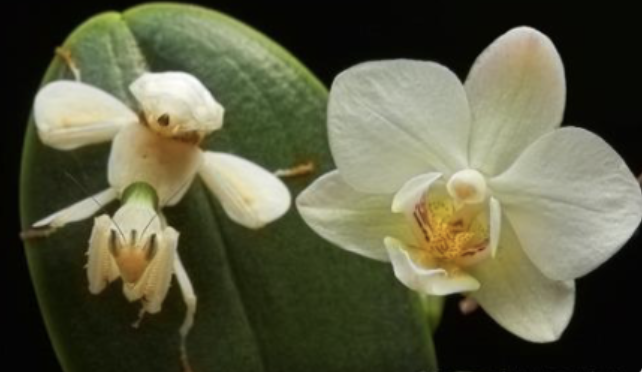
Batesian Mimicry
An unprotected species evolves to look like a protected species.
Müllerian Mimicry
A chemically protected species evolves to look like another protected species.
Red Queen Hypothesis
Predicts that species are constantly being reshaped by interactions with other species.
Each species has to run (i.e., evolve) as fast as possible just to stay in the same place (survive) because interacting species also continue to evolve
Virulence
Reduction in the survival and reproduction of hosts by a pathogen.
How much fitness cost in a parasite imposing on the species it is protecting
Virulence, infectiousness, and host resistance are traits that evolve just like other phenotypes
Mutualisms
Interactions between species that benefit individuals of both species.
Ecological Character Displacement
Divergence in response to competition between species.
What did the observation of Angraecum sesquipedale by Darwin indicate?
He predicted the presence of a pollinator with an extremely long proboscis
the long-tonged Sphinx Moth was later discovered
An example of mutualism
Concordant
phylogenies ‘match’ reflecting divergence/speciation events that are shared between the coevolving partners.
What characteristic do the Aphid and Buchner phylogenies reflect?
Phylogenies are concordant
Aphids have a bacteria symbiont Buchner that provides the insect with amino acid Tryptophan
They have evolved together
Interactions between enemies and victims?
predators and prey, parasites and hosts, and herbivores and host plants
Stability of enemies and victims interactions
Interactions are often unstable
enemies can cause extinction of each other’s populations
Arm’s race
each species adapts in response to the other and leads to
extreme traits
Predators, parasites, and herbivores evolve extraordinary adaptations to capture prey, infect hosts, and consume plants
Prey, hosts, and plants have elaborate counteradaptations.
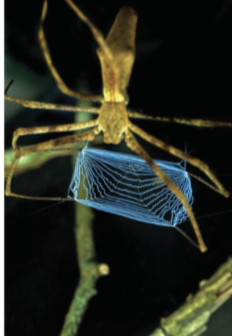
net-casting spider adaptation
holds an expandable web that it uses to quickly envelope slowly flying insects that pass by

extraordinary adaptation of parasitic trematode
migrates to the eyestalk of its host, a land snail, and turns it a bright color to make the snail more visible to the next host in the parasite’s life cycle, a snail-eating bird such as a thrush
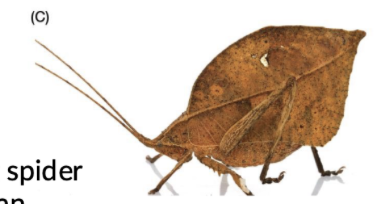
Katydids adaptations
have an extraordinary resemblance to leaves, including what looks like leaf venation and damage by herbivores
Arm’s race between Newts and snakes?
The rough-skinned newts are highly often toxic to protect from predation by the garter snake
garter snake exhibits resistance to TTX toxicity that varies to near zero to extreme high resistance
highly toxic newt populations are often paired with highly resistant garter snakes
trait matching
pattern supports the hypothesis that newt and snake traits are evolving reciprocally
not always perfectly matched
Trait matching in cuckoo eggs
Brood parasites (cuckoos) lay their eggs in the nests of other birds
Some host species can recognize and reject the parasitic eggs
cuckoos have evolved to match their host eggs
Brooke & Davies experiments (1988)
traced the fate of artificial cuckoo eggs placed in the nests of
different bird species.
Host species that are never
parasitized do not reject
experimentally placed eggs.Host populations with a history of
parasitism have evolved different mechanisms to reject experimentally placed eggs: pushing
them out of the nest, abandoning
the nest, or building over them
Cuckoo mimicry and host discrimination have each
coevolved with each other
Decaestecker ‘resurrection study’
pulling Daphnia and Pasteuria (bacteria) parasites from different sediment layers & tested hosts and parasites against each other
Hypothesis: Pasteuria evolve to optimize infectivity on Daphnia and parasites evolve to increase virulence over time
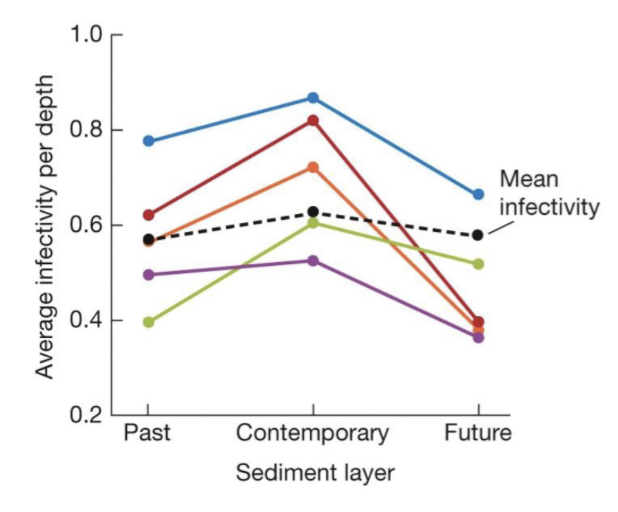
Graph shows that hosts were more frequently infected by contemporary than by past or future bacteria, indicating that hosts and bacteria were evolving in concert
satisfies coevolution that there is a temporal match between parasite and host
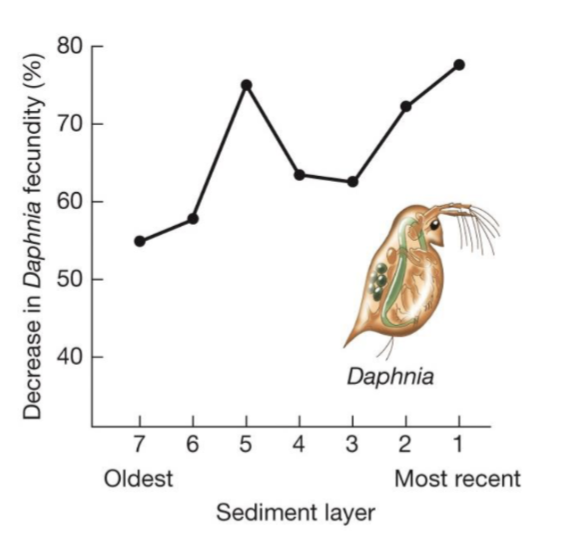
Looked at the fitness of parasite and host and noticed that the average virulence of the parasite increased over time
reciprocal exploitation
each species obtains something from the other
mutualisms between species do not show altruism, but these characters
not always stable over evolutionary time: many species cheat
Leads to coevolution
Why did the orchid’s nectar tube and the moth’s proboscis become so long?
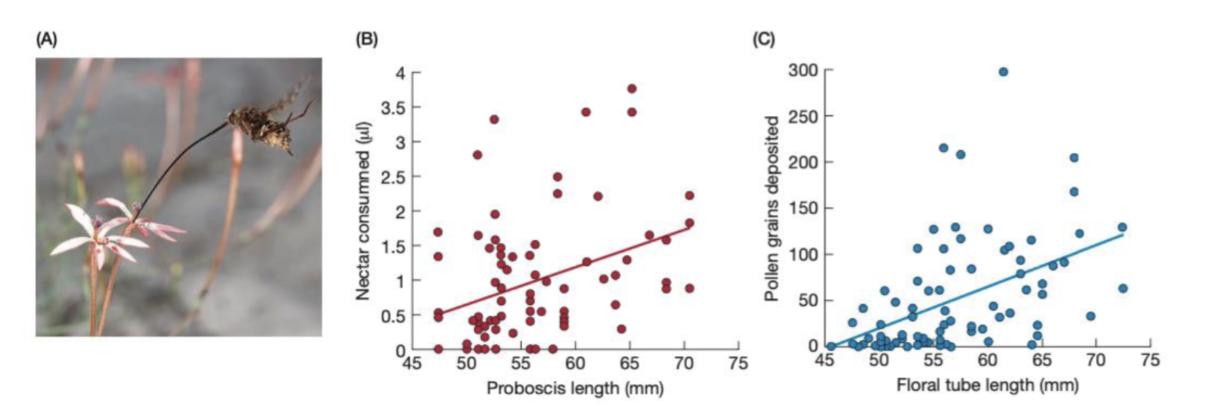
Natural selection favors:
Insects with a proboscis long enough to reach the nectar
Flowers with spur lengths that force insects to press their head deep into flowers and pick up and deposit pollen
Outcomes of interspecific competition
One species is driven to extinction.
Competition imposes selection on one or both species leading to divergence in resource use